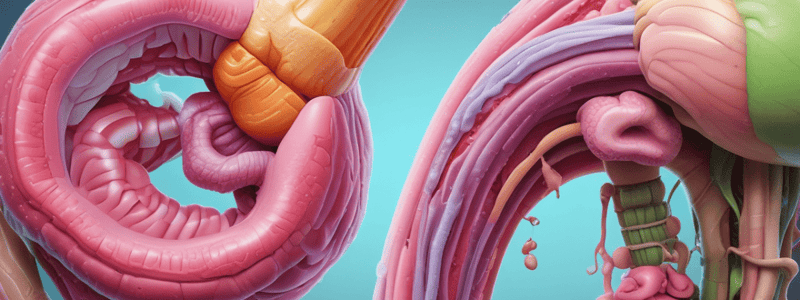Podcast
Questions and Answers
What is the main function of HCl secreted by the gastric parietal cells?
What is the main function of HCl secreted by the gastric parietal cells?
- To kill microorganisms in the stomach
- To denature proteins in food
- To aid in the breakdown of connective tissue and muscle fibers
- To activate pepsinogen into pepsin (correct)
What is the primary role of the mucus coating over the gastric mucosa?
What is the primary role of the mucus coating over the gastric mucosa?
- To neutralize acid in the vicinity of the mucosa
- To serve as a physical barrier to acid penetration
- To prevent HCl from penetrating into the gastric cells
- Both a and b (correct)
Which of the following is NOT a function of HCl secreted by gastric parietal cells?
Which of the following is NOT a function of HCl secreted by gastric parietal cells?
- Activating pepsinogen
- Stimulating the secretion of gastric juice (correct)
- Denaturing proteins
- Aiding in the breakdown of food particles
What is the purpose of the tight junctions between the gastric mucosal cells?
What is the purpose of the tight junctions between the gastric mucosal cells?
Which of the following is the main function of the HCO3- -rich mucus?
Which of the following is the main function of the HCO3- -rich mucus?
Where is pepsinogen, the inactive precursor to pepsin, secreted from?
Where is pepsinogen, the inactive precursor to pepsin, secreted from?
What is the main stimulus for fluid and electrolyte secretion in salivary glands?
What is the main stimulus for fluid and electrolyte secretion in salivary glands?
What is the composition of saliva compared to plasma at all flow rates?
What is the composition of saliva compared to plasma at all flow rates?
Where is the primary secretion of saliva produced?
Where is the primary secretion of saliva produced?
What ions are absorbed by the duct cells in the salivary glands?
What ions are absorbed by the duct cells in the salivary glands?
Which system controls the regulation of salivary secretion?
Which system controls the regulation of salivary secretion?
What is the true statement about fluid secretion in salivary glands?
What is the true statement about fluid secretion in salivary glands?
What is the role of basic PRPs and histatins in toxin binding?
What is the role of basic PRPs and histatins in toxin binding?
How does buffering in saliva help counteract the effects of microbial acids?
How does buffering in saliva help counteract the effects of microbial acids?
Which proteins in saliva function by attacking microbial cell walls?
Which proteins in saliva function by attacking microbial cell walls?
How do urea and ammonia help neutralize acids according to the text?
How do urea and ammonia help neutralize acids according to the text?
Which component plays a role in preventing microorganisms from binding to oral tissues?
Which component plays a role in preventing microorganisms from binding to oral tissues?
What is the role of carbonic anhydrase in saliva according to the text?
What is the role of carbonic anhydrase in saliva according to the text?
What is the second messenger pathway associated with binding of acetylcholine to muscarinic receptors?
What is the second messenger pathway associated with binding of acetylcholine to muscarinic receptors?
What effect does the increase in cytoplasmic Ca2+ have on the secretory cells?
What effect does the increase in cytoplasmic Ca2+ have on the secretory cells?
How is water pulled into the lumen during active fluid secretion?
How is water pulled into the lumen during active fluid secretion?
What process is responsible for the secretion of proteins and glycoproteins in the salivary glands?
What process is responsible for the secretion of proteins and glycoproteins in the salivary glands?
Which neurotransmitter binds to G-protein coupled β-adrenergic receptors to activate cAMP second messenger in serous cells?
Which neurotransmitter binds to G-protein coupled β-adrenergic receptors to activate cAMP second messenger in serous cells?
How is the transient intracellular acidification caused by HCO3- efflux recovered during high salivary flow rates?
How is the transient intracellular acidification caused by HCO3- efflux recovered during high salivary flow rates?
What type of solution is actively secreted by the duct cells in the pancreas?
What type of solution is actively secreted by the duct cells in the pancreas?
Which enzyme activates trypsinogen to its active form, trypsin, in the duodenal lumen?
Which enzyme activates trypsinogen to its active form, trypsin, in the duodenal lumen?
Why must trypsinogen remain inactive within the pancreas?
Why must trypsinogen remain inactive within the pancreas?
What is the function of trypsin inhibitor within the pancreas?
What is the function of trypsin inhibitor within the pancreas?
Which enzymes are activated by trypsin within the duodenal lumen?
Which enzymes are activated by trypsin within the duodenal lumen?
What role does enteropeptidase play in pancreatic secretion?
What role does enteropeptidase play in pancreatic secretion?
Study Notes
Gastric Parietal Cells and HCl Secretion
- Gastric parietal cells result in net secretion of HCl and net absorption of HCO3−.
- HCl activates pepsinogen to pepsin and provides an acidic environment optimal for pepsin action.
- HCl breaks down connective tissue and muscle fibers, reduces large food particles, and denatures proteins.
- HCl, along with salivary lysozyme, kills most microorganisms ingested with food.
Gastric Mucosal Barrier
- The luminal membranes of gastric mucosal cells are impermeable to H+.
- Tight junctions between cells prevent HCl penetration.
- A mucus coating over the gastric mucosa serves as a physical barrier to acid penetration.
- HCO3–rich mucus also serves as a chemical barrier that neutralizes acid in the vicinity of the mucosa.
Pepsinogen Secretion
- Pepsinogen, the inactive precursor to pepsin, is secreted by chief cells and mucous cells in the oxyntic glands.
Salivary Secretion
- Saliva is hypotonic to plasma at all flow rates.
- [HCO3-] in saliva exceeds that in plasma except at very low flow rates.
- The primary secretion is produced in the acinar cell.
- Duct cells absorb Na+ and Cl- and secrete K+ and HCO3-.
- The parasympathetic innervation provides the main stimulus for fluid and electrolyte secretion.
Regulation of Salivary Secretion
- Acetylcholine binds to G-protein coupled muscarinic receptors with IP3-Ca2+ second messenger pathway.
- Norepinephrine binds to G-protein coupled β-adrenergic receptors, activating cAMP second messenger pathway leading to exocytosis in serous cells.
Functions of Saliva
- Salivary HCO3- and carbonic anhydrase play important roles in counteracting the effects of microbial acids on tooth enamel and dentin.
- Saliva contains proteins that function in regulating the oral microbial flora.
- Proteins like lysozyme, peroxidase, mucins, and salivary agglutinin bind to and aggregate microorganisms, preventing them from binding to oral tissues.
Pancreatic Secretion
- Pancreatic juice consists of pancreatic enzymes actively secreted by acinar cells and an aqueous alkaline solution actively secreted by duct cells.
- The aqueous alkaline component is rich in sodium bicarbonate (NaHCO3).
- Trypsinogen, chymotrypsinogen, and procarboxypeptidase are activated by enteropeptidase and trypsin to their active forms within the duodenal lumen.
Regulation of Pancreatic Exocrine Secretion
- Hormonal control of pancreatic exocrine secretion is regulated by factors such as cholecystokinin (CCK) and secretin.
Studying That Suits You
Use AI to generate personalized quizzes and flashcards to suit your learning preferences.
Related Documents
Description
Test your knowledge on salivary secretion in gastrointestinal physiology including major secretions, regulation, and salivary gland anatomy.




